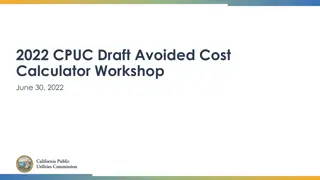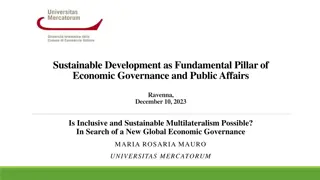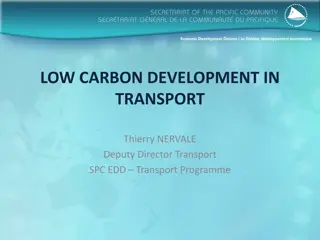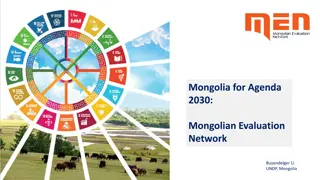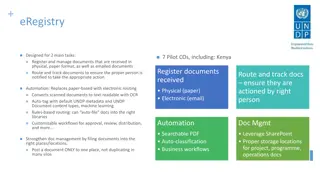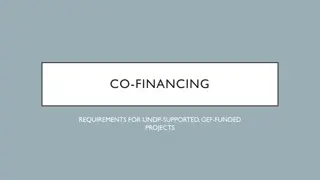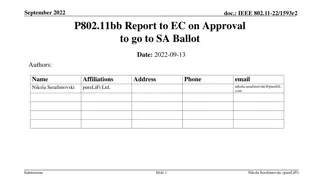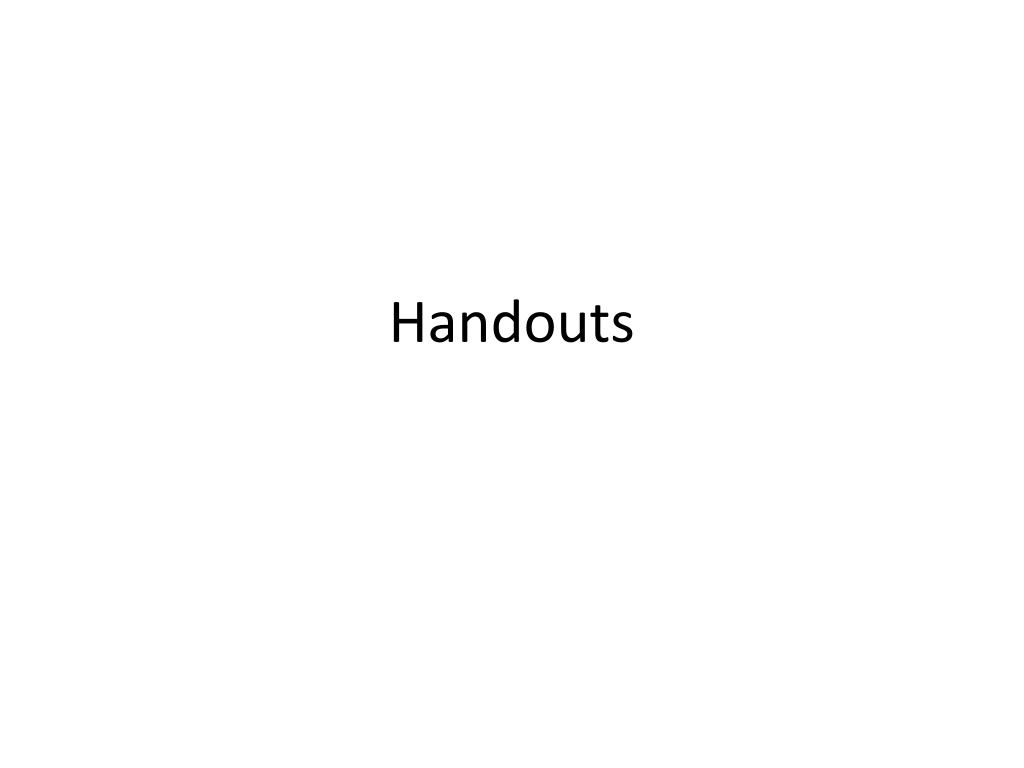
Evaluation Practices and Stakeholder Engagement
This set of handouts covers topics related to evaluation practices, stakeholder engagement, and reflection in the context of monitoring and evaluation processes. Handouts include discussions on defining evaluation, stakeholder matrices, reflection questions, literature reviews on demand for evaluation, and more. Participants can explore valuable insights and tools to enhance their understanding and application of evaluation concepts.
Uploaded on | 0 Views
Download Presentation

Please find below an Image/Link to download the presentation.
The content on the website is provided AS IS for your information and personal use only. It may not be sold, licensed, or shared on other websites without obtaining consent from the author. If you encounter any issues during the download, it is possible that the publisher has removed the file from their server.
You are allowed to download the files provided on this website for personal or commercial use, subject to the condition that they are used lawfully. All files are the property of their respective owners.
The content on the website is provided AS IS for your information and personal use only. It may not be sold, licensed, or shared on other websites without obtaining consent from the author.
E N D
Presentation Transcript
Handout 1: Person Bingo Lives in East Africa Has met a Nobel Prize winner Works on planning Lives in Central America Works in the Office of the President Lives in southern Africa Has developed a logframe Works in Parliament Has founded an evaluation network Has developed indicators X Works on strategy Knows about RBM Works in the UNDP Is an economist Knows about project management Works on M&E
Handout 2: Define Evaluation and an Evaluation System What is evaluation? _______________________________________ _______________________________________ What should an Evaluation System Achieve? _______________________________________ _______________________________________ _______________________________________
Handout 3: Stakeholder Matrix Evaluation Practice Requiring Capacity Commissioners (Demand/ principals) Intermediary Agents - Delivery and Management Supply Agents (Universities, think tanks, consultants) (Cabinet, Parliament, political parties, Civil Society, the media, donors) (Central Government (Treasury etc.) Line departments (Health etc.). User Evaluations Manage Evaluations Conduct evaluations
Handout 4: Reflection What have you found most useful? What experience from another person in the room struck you? What are the opportunities in your context for applying these tools?
Handout 5: Literature Review Review the below list of sources. What has been the actual demand for evaluation? Review of national development policy/strategy Review of budget priorities Examples of nationally commissioned and completed evaluations Evidence in media internet sources of use of evidence Identification of institutional commissions that utilise evidence in decision-making Where is there latent and potential demand for evaluation? Identification of legal mechanisms that support the demand for evaluation (e.g. constitution or committee structures in parliament) Identification of political structures that can legitimately contest policy How is evaluation demanded in the current organisational arrangements? Identification of any government frameworks for evaluation (especially in reference to sectors where there are existing social science research journals) Identification of political processes into which evidence has been used What would you add to understand the politics of evaluation? ________________________________________________________________________ What documents might be useful to help understand potential and latent demand? _________________________________________________________________________ What other questions might you add? _________________________________________________________________________ _________________________________________________________________________
Handout 6: Questionnaire Below is an questionnaire developed to understand different actual demands for evaluation within an organization. Please review Evaluation is most valuable to Org X when it: Improves how we do influencing work Helps us better respond to the citizens we work with Legitimizes to our boss what we do and how we do it Gives new insights on cross-cutting strategic issues Helps us mobilize supporters around a campaign Type of use Implementation Implementation Internal advocacy Strategic External advocacy Evaluation is most valuable to Org X when it: Provides strategic information to management Focuses on the achievement of the implementation plan for a project Helps hold government to account for how they spend money Provides globally relevant theoretical insights It helps line management understand the way we work The main reason I organize evaluations is: It is a donor requirement It is an OI policy We want to improve the implementation of the program We want to check the theory of change We want to support specific learning for Org X We want a specific learning for partners Type of use Implementation Implementation External advocacy Strategic Internal advocacy I most need knowledge that: Supports advocacy work External advocacy External advocacy Internal advocacy Mobilizes supporters Implementation Implementation Implementation Makes sure that the good things we are going are known by my CD/HQ/OI Helps implementation when it is not going well Makes sure partners voice informs the design of strategies Enhances understanding whether strategies used are effective and why I mainly used the conclusions or recommendations of the last evaluation because: We had to complete a management response for OI/back donor They highlighted concerns that we already wanted to take action on They challenged how we were thinking about change They could convince politicians or supporters of our position They gave us good ideas on improving the implementation of the program Implementation Internal advocacy Strategic Strategic Internal advocacy Implementation Reviewing your matrix to which stakeholders would you send a questionnaire ? _________________________________________________________________ __________________________________________________________ Which questions are the most important? What other questions might you add? _________________________________________________________________ ___________________________________________________________ _________________________________________________________________ ___________________________________________________________ How might you use the results of the questionnaire? _____________________________________________________________ _____________________________________________________________ Implementation Internal advocacy Strategic External advocacy Implementation
Handout 7: Semi-Structured Interviews Overall policy environment questions To which stakeholders are most important when conducting a semi- structured interview? What is the political balance between executive, legislature, judiciary, political party and civil society? What are the dominant political decision-making bodies? How decentralised in the policy environment? Who are the current champions for evaluation? How does the system deal with evaluation information that is critical? To what extent is the system open to new knowledge and evidence? Who are the major role players in defining the trajectory of policy? ___________________________________________________________ ___________________________________________________________ Which questions are the most important? What other questions might you add? ___________________________________________________________ ___________________________________________________________ ___________________________________________________________ Evaluation demand in the current organisational arrangements? ___________________________________________________________ How might you use the results of the questionnaire? What are the most important reforms taking place? What are the structured or informal relationship between academics and the organization that demonstrate a level of collaboration to influence policy? What are the links between evaluation and budgeting? When is evaluation used for policy? Who in the legislature and executive is interested in undertaking evaluations? ___________________________________________________________ _______________________________________________________ ___________________________________________________________
Handout 8: Five Whys Five Whys Problem Analysis (here)- This requires identifying a core problem then asking why sequentially five times. This analysis can help to better understand latent demand through identifying underlying organizational issues to which evaluation could respond. Reviewing your matrix with which stakeholders would you conduct a Five Whys analysis? ________________________________________________ ________________________________________________ Example 1: Individual Response We don t yet have a way to evaluate whether we are succeeding or failing on a fast enough feedback loop Why 1 - We don t have a shared way to declare progress indicators towards a long term vision that works in different contexts and across different teams Why 2 - No usable theories of change. We have not made clear the causal assumptions that will drive our programming decisions towards those progress indicators in any theme. Why 3 - No updated long term vision towards which the theory of change is driving. We haven t connected our progress indicators to a longer term decision on a strategic vision. Why 4 - No final decision on what we will do to refine or develop strategic plans Why 5 - The new Thematic directors are not in place. With what types of demand would these results help understand? _______________________________________________ _______________________________________________ How might you use the results of five whys analysis ? ________________________________________________ ________________________________________________ ________________________________________________ Multiple responses helps to identify challenges that an evaluations system needs to work through Example 2: Collated Responses Challenge Example How to get to success requires further definition Most of the individual issues stem from a systemic culture of over-ambition that s masked as a holistic approach to ending poverty No updated long term vision towards which the theory of change is driving. We haven t connected our progress indicators to a longer term decision on a strategic vision. Challenges in supporting learning Evaluations are one-off and do not feed in a structured way into organizational learning, planning and training Challenges in the use of evidence Lack of commitment from leadership to ensure uptake of evaluations in campaign and program design Challenges in measuring and understanding effectiveness We wish to support a diverse range of ways to measure outcomes and outputs, which means it hard to select a single suite of tools to support the process Challenges in implementing matrix relationships Why were they not well connected? A: The Divisions leaders had different visions for what MEL is for, plus the Divisions have always been in competition with one another. Unclear accountability for program quality



